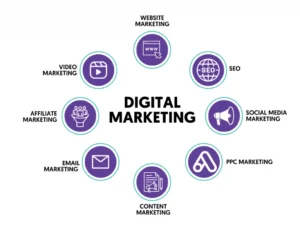You’ve probably heard people talk about “digital marketing strategy” like it’s some secret sauce. In reality, a good strategy is nothing magical—it’s a plan that brings all your marketing efforts together so they work instead of compete.
Let’s walk through how you can build a strategy that actually delivers, step by step, using real examples. No fluff, no jargon.
Why You Even Need a Digital Marketing Strategy
Imagine trying to hit a target while blindfolded. You might hit something by luck, but rarely the bullseye. That’s what marketing without a strategy feels like.
A digital marketing strategy gives you direction. It ensures your social posts, ads, emails, and website all aim toward the same goal. It turns scattered actions into meaningful results.
Core Elements Your Strategy Must Include
Here are the pieces you need to build something real:
- Audit & Insight
Start by looking at what’s working and what isn’t. Maybe your blog gets some traffic, but your product pages don’t convert. Or your social media reaches many but doesn’t bring visits to your site. This “taking stock” phase helps you spot gaps and potential. - Goals & Metrics
What do you really want? More sales? More leads? More brand awareness? Define goals clearly. Then pair each goal with a metric: number of leads, conversion rate, sales revenue, email opt-in rate. - Audience & Personas
Know who you’re talking to. This isn’t just “men 25–40.” It’s about their problems, what they care about, where they spend time online. If you know this, your messages will resonate more. - Channels & Tactics
This is the fun part. Here’s how your tactics might look:
- SEO and digital marketing: Optimize your site so people find you when they search.
- Website marketing strategy: Make sure your site supports your goals—fast pages, clear calls to action, mobile design.
- Online marketing strategy: Decide whether social media, email, advertising, content will support your goals.
- If you run an eCommerce store, you might enlist ecommerce marketing agencies or strategies to maximize conversions.
- Budget & Roles
You might have a small budget or a big one. Either way, decide how much goes into ads, tools, content. And assign who does what—perhaps you hire a digital marketing strategist or delegate in your team. - Measurement & Optimization
You don’t set and forget. You test. You see what works. You refine. Over time, your strategy evolves.

Example: How Brands Use Strategy to Win
Let me share two stories so this feels more real:
- Amazon’s approach: They didn’t just sell things online—they built a marketing machine. Every page, email, ad, and offer is interconnected. Their strategy is sharply focused on customer experience, measurement, and iteration.
- Gift & Collectible Brand: An eCommerce brand partnered with a marketing team that ran ads, optimized SEO, improved the checkout flow, and used email follow-ups for abandoned carts. Their strategy spanned across channels, not just putting ads and hoping.
These aren’t overnight successes. They got traction because they tied everything together with strategy.
Why “SEO + Website Strategy” Can’t Be an Afterthought
When people search for what you offer, you want your site to be ready. That’s where seo and digital marketing meet website marketing strategy.
- Keywords should match how people search.
- Pages should load fast and look good on phones.
- The user journey should guide visitors toward the action you want (buy, sign up, contact you).
If your site fails here, all the marketing you do will leak value.
Pitfalls to Watch Out For
Many strategies fail because:
- People jump into tactics (ads, posts) without plan or consistency.
- They spread across too many channels and do none well.
- They don’t measure or adapt—so they keep doing things that don’t work.
- The website is weak—slow loading, broken design, confusing navigation.
Steer clear of those mistakes. Focus on doing fewer things well.
Your Action Plan: Build It in 8 Steps
Here’s a roadmap you can follow this week:
- Audit your current efforts—see weak spots.
- Pick one or two goals you most care about.
- Define your audience and their pain points.
- Choose one main channel to start (social, SEO, email).
- Optimize your website to support your goal.
- Execute small campaigns or content around that.
- Track metrics daily or weekly—see what works.
- Optimize, drop what fails, double down on what succeeds.
FAQs Quick
- What is digital marketing strategy?
A plan that integrates your tactics—ads, content, SEO, website —so they work together to hit goals. - How do SEO and digital marketing work together?
SEO drives people to your site organically. Other efforts (ads, content) support SEO by bringing visitors, building links, etc. - What is an online marketing strategy vs general strategy?
Online marketing strategy focuses on internet channels—social, search, ads, email—while general strategy may include offline too. - What does a digital marketing strategist do?
They map out goals, choose tactics, align teams, measure, and steer adjustments. - Why involve an ecommerce marketing agency?
If you’re selling online, these agencies bring experience in optimizing ads, funnels, checkout, and conversion—fast. - How does website marketing strategy fit in?
Your website must support your strategy—be fast, usable, conversion ready. It’s your strategy hub.
Conclusion
A digital marketing strategy isn’t optional if you care about real, lasting results. It’s what ties your marketing channels into a machine that works together.
Start small. Build your website, choose one tactic, measure it. Adjust. Grow. As your strategy matures, you’ll see how SEO, your site, ads, and content amplify each other. And your brand will stand out.